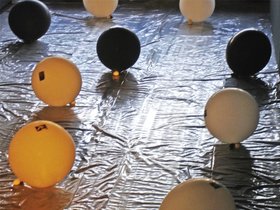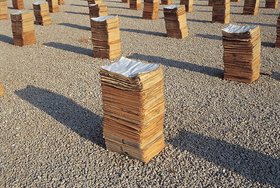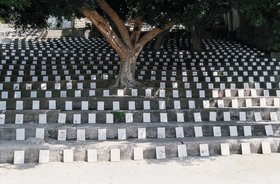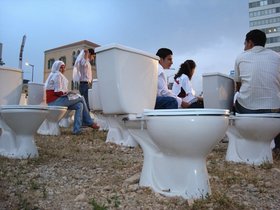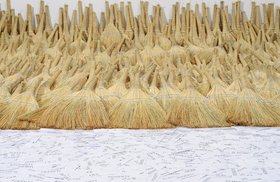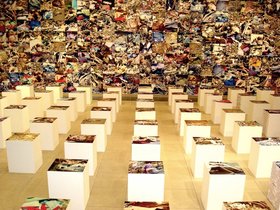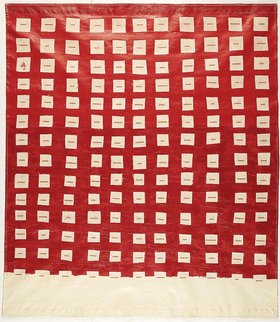Interviews
With Inside Outside
Nada Sehnaoui in conversation with Laura Allsop
The work of Lebanese artist Nada Sehnaoui tackles the contested issue of public space in post-conflict urban environments with a meditative aesthetic that engages forms of repetition. The artist often fills vacant lots in the downtown area of Beirut with hundreds of repeated items, be they toilets or stacks of paper, and encourages viewers to reflect on how the space is being, and has been, used through their engagement with these often idiosyncratic objects.
In this interview for Ibraaz, Sehnaoui talks to Laura Allsop about the importance of reclaiming contested sites for the public, of involving the public in her work, and of navigating the thorny path to gaining access to public space. In doing so, she not only hopes to create ephemeral, interactive memorials to an internecine war whose scars still remain etched into the fabric of the city, she also wants to trigger, in her words, 'a reflection on how to build a civil state.'
Laura Allsop: I wanted to start by asking about a statement you made as part of a panel discussion at London's Royal College of Art during the opening of the exhibition Subtitled: With Narratives from Lebanon (2011). You asked the question of how one could reclaim a city ravaged by war, especially when the memories of Beirut, for example, are being continually erased. And I wonder if you could talk a little bit more about this issue of urban reclamation, because a lot of your public installations seem to take back public space that is either left vacant or awaiting development.
Nada Sehnaoui: The process of reclamation is about the physical space of the city as well as the history and the memory. The problem in Lebanon, especially just after the war, is that there was an amnesty law that gave a truce to everybody so there were no trials, there was no accountability, nothing like in South Africa for example with its 'Truth and Reconciliation Commission'. So it was like a tabula rasa, like nothing happened here. We kiss each other on the cheek and we move on and that's fine – the problem is that it doesn't work. I wouldn't mind if it did! But it doesn't, the outcome is negative, you tend to repeat all the traumas and the problems and the conflicts if you don't look back and reflect. The reclamation is therefore physical, in terms of the physical space and the geography because the Lebanese war happened downtown, and downtown Beirut has been emptied of its life; people were not allowed there for a period of 15 years. It was a battle ground, the playing fields of militias of all sorts. My large-scale installations, like Fractions of Memory (2003), which is about the memory of Beirut before the war; or Waynoun, Where Are They (2006), which is about the people who disappeared in Lebanon during the Civil War; and more recently, Haven't 15 Years of Hiding in the Toilets Been Enough? (2008), for which I put 600 toilets in a public space: all were downtown in vacant lots either emptied by the war or by the reconstruction project, in an effort to bring back the urban dweller to those lost spaces. It comes from a desire to fight the physical and emotional tabula rasa of our memory and our past with the hope of being able to project onto a future that we can envision, not a future that again will be imposed on us.
LA: I wanted to talk about Fractions of Memory and particularly about the way you arranged the piles of papers that make up the installation. You asked members of the public to write down their memories of downtown Beirut before the war and you collated these and arranged them into stacks that look almost like tower blocks. Is it a metaphor for the building boom and Solidere building these tower blocks now in places that were former battle grounds?[1]
NS: I like your analysis. The beauty of it is that you have an idea, you have an urge and when you go public and create the work, your mind works in a compulsive manner and you have no choice but to do what you're doing. And then the viewers have all kinds of readings – the way you said it, it was never part of the project, I never had it written on a piece of paper that I wanted to create towers but this is the beauty of it, the multiple interpretations. It tells me that the work has been received and enriched.
LA: You quite often ask members of the public to share experiences with you – how important is it to involve people in your work and to really extend the artwork to people in that very direct way?
NS: For me it's very important to do so, because it means you're not just an individual working on a project. My work is about collective memory, public spaces and the reclamation of memory and space and that involves more than just the person who initiated the work. So whenever I can, I call for other people to be involved in my work. For instance, I did a work called Promenade in your dreams (2001) for which I asked some school kids in Lebanon to describe the school of their dreams. In France, I asked middle school children to interview their parents about their origins and about how their families came to the Marseille area. Even in my paintings, I tend to collect and work with texts.
LA: So it's a kind of collaboration?
NS: It is a way to relate to the world. It protects you from the isolation of the studio; you have a sense that others are involved with you when you work.
LA: I wanted to talk about the notion of bringing the private out into the public, because for example with Haven't 15 Years of Hiding in the Toilets Been Enough?, you bring what is a very private space out into the public. There is also your installation To Sweep (2011), which I saw in London a few months back, which is composed of broom-heads, very domestic objects; also in your work Rubble (2009), where you photograph household items destroyed in the war that you found in the street. On the one hand, when the artist does it, it's a reclamation of the space; but with Rubble you're picturing a violence that has been done to the domestic space, that has brought it forcibly out into the public. I wonder if you could talk a little bit about that tension between the public and the private?
NS: When the Civil War started, I was a teenager and suddenly war came into our homes and changed the way we lived our private lives. This was imposed on us; it was not a choice we made. Whatever happened in the public realm then changed our relationship to our homes and to our private spaces. During the war, the bathroom became a refuge, a shelter where we could hide from the bombs. So it's a bit like a ping pong game, I'm sending the private space back into the public space, hence the 600 toilets seats installed in downtown Beirut.
When you live in a country like Lebanon where you are often threatened by a conflict of some sort, all of us, even visitors, are sometimes suddenly confined to our domestic spaces. You cannot go to work, you cannot go to school, and you cannot just walk by the sea or down the street to get some groceries. Confined at home, domestic life becomes obsessive, so I tend to use and multiply domestic elements in order to do the work I need to do. With the installation To Sweep, where I used hundreds of brooms, it was inspired by images of people sweeping up after a bombing, which you see all the time, from Lebanon to Sarajevo. And for me it was not only rubble we needed to sweep but political systems, dictatorships and tyrannies. I did this piece a few weeks before the revolution started in Tunisia in 2010.
LA: Is there something about the domestic, which can be shattered by these incursions, but which invariably continues – that these kinds of domestic configurations will continue regardless?
NS: Yes, and hence the repetitive element in my work, we go on. We wake up again in the morning, it's a prayer or a meditative will.
LA: I've noticed that in a lot of your installations, you tend to arrange things into grids and I wonder if the grid has a specific resonance for you in terms of urban organization and if that kind of urban organization is a desirable one? It's a very neat type of organization, like New York with its grid system; whereas Beirut is more chaotic, a sprawl. So I wonder if you could talk more about this?
NS: New York is a good example of a grid and chaos at the same time. I think that what I hope to do, especially with my public installations, is to try to create tranquil public spaces that do not interrupt the movement in the city. I want to keep the existing paths, renew the old ones destroyed by the war and the reconstruction and create new ones. My hope is to create meditative, quiet spaces in Beirut and to invite people to these newly reclaimed spaces. And to let these spaces speak about our loss of memory and to invite people to reflect individually upon what happened but in a collective space.
LA: And how easy is it for you to use these public spaces – are they vacant lots, are they being developed, do you need to get planning permission, how does it work on the urban level?
NS: The permit for the first installation was extremely difficult to get, because the different authorities in charge of the urban space didn't even understand what I wanted to do and I was asking to use a 3,000 square foot space in downtown Beirut. So, yes, it was very difficult. It felt like I was asking for a permit to actually build a building. But it's getting a bit easier because they have seen the work I've done already, so the permits are coming a bit more easily. But at the same time, I have an installation that has been cancelled so many times over the years and which I'm hoping to do this summer, but every time I try to do it, something happens: the Hariri assassination, the series of assassinations after that, then the Israeli bombing and invasion and so on. It's never easy but you just try to do what you have to do.
LA: And what is the work?
NS: It has changed so many times and it's not the same anymore. It's now called Light at the end of the tunnel. I would have to show you images when it's done. If I tell you, it would be quite abstract. I'm using stools and turning them on their sides and then with these stools, I'm going to create six huge tunnel structures in an empty space. I was supposed to do it in December 2011 in a space in downtown Beirut, but it turned out that the space was still under probation and could not be used before several months. Things like this crop up all the time.
LA: And in this case, where the project has stopped and started so many times, has it gone through the same number of evolutions in terms of content?
NS: Originally, I was using the stools as regular stools and it had a completely different title, it was in memory of the time when we were forced to sit in our homes and wait because of the war. It came with a text where I wrote that at 16 I didn't sit to study, to read or to watch TV; I was sitting to hide in a shelter. And I did not sit alone, as the whole country sat with me, each in his or her shelter. So this was in memory of the sitting period, and I had 400 stools and people were meant to sit on them and read attached texts written by many different people, but it never happened. I think I am done with the sitting and the stools so they will now be on their sides.
LA: How do these installations relate to the idea of the public memorial? Memorials to wars tend to be sculptural, but at the same time are very fixed, monolithic structures. There is a political reading of this which is problematic, in that they are representative of an imperialistic stamp on memory, seeking to contain an entire conflict, and the structures are usually these immutable slabs, stelae or obelisks that seem to negate any possibility of further dialogue on the subject of the war they commemorate. You are presenting something more ephemeral, something which can be installed and de-installed and interacted with. Could you maybe say something here about that aspect of your work?
NS: As humans we are faced with the certainty that everything is ephemeral, and my work reflects this idea. It is the opposite of the monolithic monument. It is in its physical essence multiple, and invites in its process multiple discourses. It is in many ways an ephemeral public memorial. I am hoping that one day we will have in Beirut a space dedicated to the memory of the war which would not reflect the illusion and rigidity of immortality or reproduce the single discourse of the victor, but a space where people from all walks of life could reflect on the past and project onto the future.
LA: A lot of your work is tied to the Lebanese context but has a resonance outside of that. Is this something you think about in your practice, the question of how does something that is tied to a specific place in time also transcend that space in time for people who are not from that region and maybe do not know about the specifics of the Lebanese Civil War?
NS: With the installation Rubble, which you mentioned earlier, I wrote a sentence that read: 'Rubble is a meditation on the ongoing capacity of human beings to reduce other human beings' lives to rubble'. I took the many images in this installation when I went to southern Beirut a few days after the ceasefire in 2006. I was taking these pictures literally like a zombie, I was numb. I had seen images of huge buildings destroyed on the TV, and I was not interested in that at all as I was totally flabbergasted, I couldn't believe what I was seeing on the floor: toys, clothes, furniture, books and so on. I zoomed in and took hundreds of images, which became Rubble. A few years later in 2010, when I saw Christian Boltanski's exhibition at the Grand Palais in Paris, which he filled with a mountain of clothes, it reiterated the fact to me that this did and can happen anywhere.
LA: I saw in an interview a while back with Prophecy magazine that you responded to a question by stating: 'I want to trigger a reflection on how to build a civil state'. And I wonder if you could speak more broadly on art's role in triggering such a reflection?
NS: A civil state is a dream that hopefully will come true. I mean, in Lebanon we don't have civil marriage, we only have religious marriages. I'm part of a group that would like to instil civil marriage. Lebanese women dress fancy, they go out, they are ostensibly emancipated, but you look at the texts and you see that in reality they are legally deprived, they cannot pass on their nationality to their children; in case of divorce, the 17 Lebanese communities have horrendous custody laws to the detriment of the mother and the children. Medieval laws still apply, homosexuality is still a crime, and it goes on and on. So yes, there is a lot to do. One of my early paintings was about an artist who has since passed away and whose husband took away her child on his seventh birthday and dumped him in a boarding school. He was legally allowed to do that, and my painting is called Legal Violence (1998). The painting is a grid where I repeated her sentence: 'At seven, he came and took him; he took him and put him in a boarding school'. I think it's important to live as citizens; there is a lot of talk about brotherhood and kissing each other on the cheek, but it's more important to be responsible citizens in a country with equal rights. 'We will learn to live together like citizens or die together like idiots', was the subtitle of my last public installation Haven't 15 Years of Hiding in the Toilets Been Enough? My hope is that art could trigger a reflection, at least.
LA: My last question is what are you currently working on? You mentioned Light at the End of the Tunnel ...
NS: I pray for that, and hopefully it will happen this summer in Beirut. I'm also starting a new body of work, mostly paintings; it's still very much in the early stages.
Nada Sehnaoui is a Beirut-based painter and installation artist whose work deals with issues of war, personal memory, public amnesia, the writing of history, and the construction of identity. In her paintings and installations she often works with layers – of colour, objects, memory, the city of Beirut itself – surviving through war and reconstruction. Since 2001, she has been creating installations that constitute spaces for personal meditation and social reflection. Sehnaoui has had solo exhibitions in Beirut, New York City, Boston and Doha, and has participated in many group shows in the US (Washington D.C., Houston, Boston), the Middle East (Algiers, Abu Dhabi, Beirut) and Europe (Paris, Strasbourg, Munich).
www.nadasehnaoui.com
[1] The name 'Solidere' stands for 'Société Libanaise pour le développement et la reconstruction de Beyrouth', or 'The Lebanese Company for the Development and Reconstruction of Beirut'. Critics of Solidere argue that the company is effectively erasing the city's history in favour of real estate development and short-term profit.

